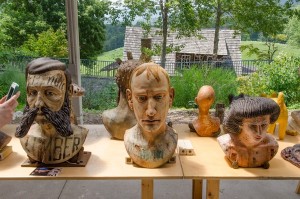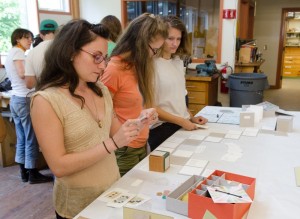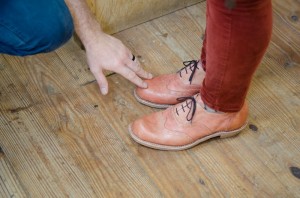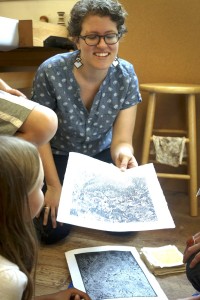It’s the last day of the session and I need to find Orly Wexler in Upper Metals. When I get to the studio, Orly is gone. “She left at 5 am to catch her flight,” says the instructor, Lawrence Woodford. He sighs. “Her work was so beautiful.”
Dang. Two weeks at Penland can go quick–just when I get used to people being here, they’re off. Next on my list to track down for her story: Martha Todd in lower Clay.
Martha, recipient of a Penland fellowship through the Crafts Council UK, has been blogging about her Penland experience in Thaddeus Erdahl‘s workshop. I would like to meet and interview her for the blog before she leaves. On the porch of Lower Clay, the busts the class has made are out: cats, humans, animals grand and strange. I find Martha’s bust–a dog–but no Martha. Someone tells me that she’s headed toward the coffee house wearing a pink shirt.

When I get to the coffee house, there are three women with pink shirts. Dang again. Here’s an occupational hazard of working in the Penland communications office during the summer: the cast of students and instructors changes in a flash. Too many luminous people to chase. Too many names. They appear, make art, and then leave us. To complicate matters, people reappear with steady frequency. My brain hurts.
I approach a familiar woman in pink near the creamer and ask if she’s Martha Todd. “No,” she smiles warmly, “I’m Mary.” It isn’t until later that I realize she’s Mary Zicafoose, textiles instructor and maker of the brilliant-colored tapestries I saw, days ago, displayed in Lily Loom.
Mary, my bad.

I head to the wood studio for Show and Tell, a chance for all classes to display their work before heading home. The studio is packed. A sea of Penlanders crowds around tables. Shane Fero‘s flameworking students stand close to their dazzling pieces and organize trades. I sidle up to the table with forged steel works, and watch as a woman nearly stabs her arm on branches extending from an inflated steel form. Near a window, young James Haley escapes the dangers of crowds and art by playing with nesting cork forms made by someone in the cork design class. Hi, James.
I snap Elizabeth Brim‘s picture but it’s the wrong moment (another occupational hazard of my job: Pictures Taken at the Wrong Moment). Elizabeth is talking with a woman I’ve noticed all summer. She’s carrying Donna Tartt‘s The Secret History. “I’ll loan it to you when I’m done,” she says when I ask how she’s liking it. I should know her name. But at that moment Paulus Berensohn goes by, slow, like some unearthly snow king. And it’s true, you just want to watch him float.
I end up outside chatting with iron coordinator Daniel Beck and Adam Whitney. Adam looks very tired after captaining the metals workshop this session. He wants to fit in some of his own work before he heads back to Detroit. “You have Flutagon?” he asks Daniel, and I laugh because it’s true: the language of metals sounds like Klingon. “Yeah, you know, Flutagon, Atlantic 33,” says Daniel, jokingly, when I say that I’m about to totally tune out of their conversation.

Lately, I’ve been thinking about my job at Penland as “chasing Penland.” I chase people. I ask them what they do and listen. But in the summer, I’m more like a slipping glimpser. I take a last pass around Show and Tell. Shoemaker Malika Green in bright orange pants, saying goodbye. Nearby, a woman packs up the board game she made in Julie Chen‘s class. The table is thinning out. One of the remaining board games displayed is by studio assistant Isabel Duffy. “In process,” reads a sign. It’s impossible to tell what the game is, or if it’s even meant to be played, and one of the face-out cards reads:
If possible, forgive anyone who is upset that time alone is still necessary and desirable. After the long countdown and anticipation of return, intimacy is one of the things that cannot be pulled out and expected to unfold without creases.
It’s a shock to read this here, at Show and Tell: a quiet and difficult thought about one’s need to make art. Isabel’s words suddenly make the whole thing emotional: how fleeting Penland time is for our students and instructors, who have left their cities and homes and respective intimacies to come here and work like total maniacs.

Everyone starts to trickle toward the Pines for lunch. In a corner, instructor Evie Woltil Richner kneels with a portfolio of her prints. They spill out on the floor. I try to photograph what’s happening: Evie showing her prints to Tiffany Dill‘s young daughters, and asking them which ones they like. This one? Maybe this one? Interest is expressed. Evie stops. “I’ll trade you this for one of your drawings, okay?” The deal is sealed.
Yes, the world is not all magic and pure exchange. But sometimes it is.
—Elaine Bleakney

